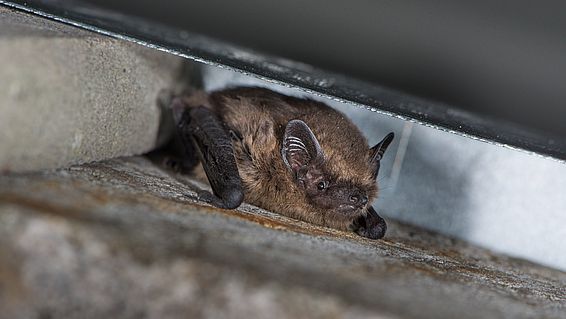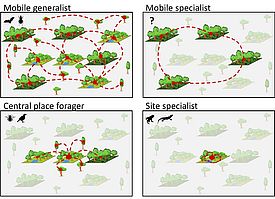23.11.2023 | Tamara Baumann | WSL News
Cities are not the natural habitat for wild animals. Only animal species whose behaviour is compatible with the urban environment survive there. An international study involving the Swiss Federal Institute for Forest, Snow and Landscape Research WSL analysed the traits of wild urban animals and identified their survival strategies. This knowledge should be considered when planning green spaces to preserve biodiversity in the city.

The growth of cities and urban areas is one of the main causes of species loss worldwide. Many animal species are deprived of their natural habitat. Green spaces in cities are often small and fragmented. Animals also must cope with higher temperatures in cities, air and light pollution and heavy traffic. "Cities are a sort of filter for local biodiversity. Animal species that cannot find food or places to breed and raise their offspring are filtered out and disappear," explains WSL ecologist Marco Moretti.
Nevertheless, cities can harbour a high biological diversity if the different needs and survival strategies of species are taken into account when planning and managing green spaces. Because animals can survive in cities in a number of ways. This is shown by a recent study with the participation of WSL published in the renowned science magazine nature communications.
The international research consortium analysed traits related to survival, growth and reproduction in bees, carabid beetles, birds, bats, amphibians, and reptiles. They collected data from 379 cities on 6 continents including tropical regions and species groups that had previously been studied to a limited extent.
Mobile bats and picky reptiles ¶

The researchers had expected to find mainly generalist species in the cities, which can feed from a variety of sources and are not fussy in their choice of nesting and breeding sites. Specialists that depend on specific food sources or breeding sites usually have a more difficult existence in cities.
However, the analysis shows that specialists also have a chance of survival if they find suitable living conditions. In fact, the researchers found different survival strategies, which they categorised into four 'urban trait syndromes' (see box). They differ primarily in how the animals find food and reproduce.
Amphibians and reptiles have little chance of finding suitable breeding sites in cities (ponds or sunny, quiet areas). They remain in the same area for the entirety of their lives and are specialised in the food available there. This specialisation reduces competition for food and allows more animals to live in a confined space. However, these barely mobile specialists are highly endangered in cities by the loss and fragmentation of their habitats, lack of food and environmental pollution. As a result, the populations of such site specialists are at greater risk of extinction.
Birds and wild bees mainly live in a central location from which they forage in the surrounding areas. However, they are less picky about their food and eat what they can find. The study further showed that birds with a small number of offspring are more likely to live in cities. This increases the likelihood of the individual chicks to obtain enough food and survive.
Typical generalists with high mobility, on the other hand, are carabid beetles and bats. Some bats living in cities are equipped to cover the great distances between nest sites and food sources. They move freely around the city and utilise the various foraging opportunities that it offers.
Avoiding traps for biodiversity ¶
The study confirms that cities provide space for many different species. "However, important resources for animals must be protected. Especially places for reproduction, which are rare for many specialised species," emphasises Moretti. Biodiversity and the different needs of the animals should therefore be taken into account in urban planning.
For Switzerland, for example, this means that although cities should become more densely built, sufficient green spaces should also be planned that are adapted to the different ecological needs of the various species. "For example, rooftops could be covered with more greenery," suggests Moretti. "Bridges or corridors between different green spaces are also important." Without connecting pathways, small, isolated areas become traps for those organisms that cannot spread. This increases the risk of inbreeding and a decline in populations. The quality of green spaces is also of importance, as Moretti explains: "Green spaces should provide space for many different plant species. This will increase the biodiversity of insects, which in turn are a food source for birds and other animal species."

Four strategies for surviving in cities
Not being fussy is the strategy of the mobile generalists. Bats and carabid beetles survive thanks to a diverse diet and high mobility. In this way, they can fly longer distances and move more easily between fragmented and isolated green spaces.
In contrast, there are the site specialists, which include amphibians and reptiles. They live in favourable habitats, which they will not leave for the rest of their lives. They are also specialised in a specific food source. This reduces competition among animal species in small areas and allows multiple ecological niches to be exploited.
Central place foragers are mobile, but still dependent on their nesting site. These animals live in a central location from which they undertake foraging trips. Bees and birds, for example, exhibit this strategy. Both are not as mobile as some birds on the countryside, but they are less selective in their diet.
A fourth strategy of mobile specialists can be derived from the three strategies observed. While this strategy was not observed in the study, there is reason to believe that there are mobile species that specialise in a particular diet. They may forage widely for their food source without having to return to a central location.
Urban trait syndrome
Mobility
Feeding
Reproduction
Mobile generalist
Increased mobility
More generalist diet
Diverse strategies + diverse locations
Mobile specialist
Increased mobility
More specialist diet
Diverse strategies + reduced locations
Central place forager
Site fidelity
More generalist diet
Reduced strategies + reduced locations
Site specialist
Reduced mobility
More specialist diet
Reduced strategies + reduced locations
Always up to date: Subscribe to the WSL Newsletter
Contact ¶
Publications ¶
Hahs A.K., Fournier B., Aronson M.F.J., Nilon C.H., Herrera-Montes A., Salisbury A.B., … Moretti M. (2023) Urbanisation generates multiple trait syndromes for terrestrial animal taxa worldwide. Nat. Commun. 14(1), 4751 (14 pp.). https://doi.org/10.1038/s41467-023-39746-1Institutional Repository DORA
Copyright ¶
WSL and SLF provide image and sound material free of charge for use in the context of press contributions in connection with this media release. The transfer of this material to image, sound and/or video databases and the sale of the material by third parties are not permitted.
